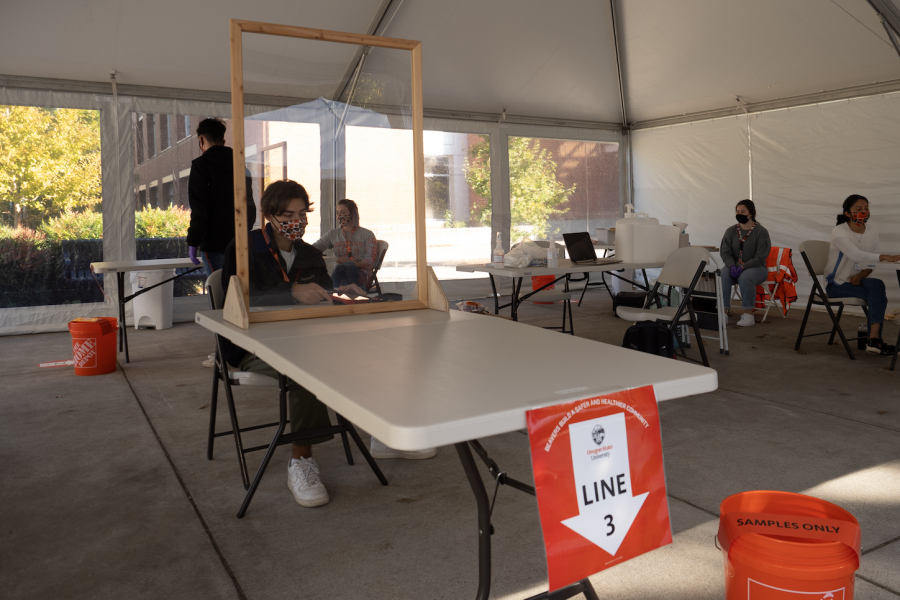OSU, UO collaborate on COVID-19 TRACE testing
November 16, 2020
Oregon State University’s COVID-19 TRACE testing project has partnered with University of Oregon in Eugene, Ore. to expand COVID-19 prevalence testing in Oregon cities.
“OSU faculty and UO faculty are in frequent communication and collaborate on various research projects,” Steve Clark, vice president of university relations and marketing, said via email. “Since spring, faculty from both universities discussed possible collaborations to address COVID-19.”
According to Clark, the chance for collaboration came about when the Lane County Public Health Department asked for TRACE Community to conduct prevalence testing in Eugene.
Health Administrator Jocelyn Warren from Lane County has stated that she views the county as a collaborating partner in the TRACE project.
“Although UO does not have a School of Public Health, Lane County collaborates closely on a number of initiatives with the UO, including their Global Health program and with partners in Prevention Science,” she said via email. “Lane County also collaborates closely on other COVID-19 activities in testing and behavioral research.”
At UO, support is provided in part by the staff and students affiliated withPrevention Science Institute at the university. Leslie Leve, a professor at UO, is the associate director of the institute.
“The institute has the mission of understanding human development, preventing behavioral health problems and implementing effective interventions in community settings,” Leve said via email. “As such, OSU’s TRACE program was a natural partner with some of our staff’s skills and interests.”
Some students and staff who are members of the Prevention Science Institute worked alongside OSU team members on Nov. 7 and 8, collecting samples from households in the Eugene community.
Approximately 30 three-person teams — each team made up of a health professional, OSU student and UO student — traveled throughout the Eugene community and randomly collected samples from 600 household residents in the city.
TRACE Community Eugene is being funded by PacificSource Health Plans, which is based in Springfield, Ore. TRACE has also been funded by the Packard Foundation, PacificSource Health Plans and OSU. In Hermiston, Ore. the Oregon Health Authority paid for TRACE Community sampling.
“In each county where TRACE Community does household sampling, the local county health department has been an important partner in ordering these medical tests, assisting with the engagement of community health care professionals, receiving testing results and engaging in any needed contact tracing,” Clark said.
However, the TRACE collaboration is not without its challenges. According to Clark, each weekend of TRACE sampling and testing requires extensive planning, execution, timely testing of samples, careful analysis of prevalence results and significant communications within each community to build awareness and promote participation.
The benefits still outweigh these challenges, as OSU and UO faculty share their expertise and their added strength.
“Students from each university benefit by working together, building friendships, sharing knowledge and experiences and serving Oregonians by working together,” Clark said. “TRACE Community’s work in Eugene can serve as a model of collaboration for other engagements between the two universities and inspire collaboration among other universities nationally.”
Leve also believes that the benefits from the TRACE collaboration are extensive, in particular a grant provided to UO from the National Institutes of Health that focuses on increasing testing in Latinx communities throughout Oregon.
“The work of OSU’s TRACE program is helping us by providing estimates of community prevalence rates that will be useful in informing our decisions about how to expand testing to more communities in Oregon for this grant,” Leve said. “In addition, we are hopeful that if this new research project includes Linn or Benton counties, that there might be OSU team members interested in participating in some of our testing and intervention activities.”
Warren is also hoping that the TRACE collaboration can improve the county’s overall knowledge of COVID-19 infection rates throughout county citizens.
“We have had good local access to testing, with local organizations [setting] up COVID-19 testing to meet our regional needs and supplement the Oregon State Public Health Lab,” she said. “However, we know many people do not seek testing and we are eager to see what the TRACE project can tell us about how widespread the infection is in our community.”
























































































































